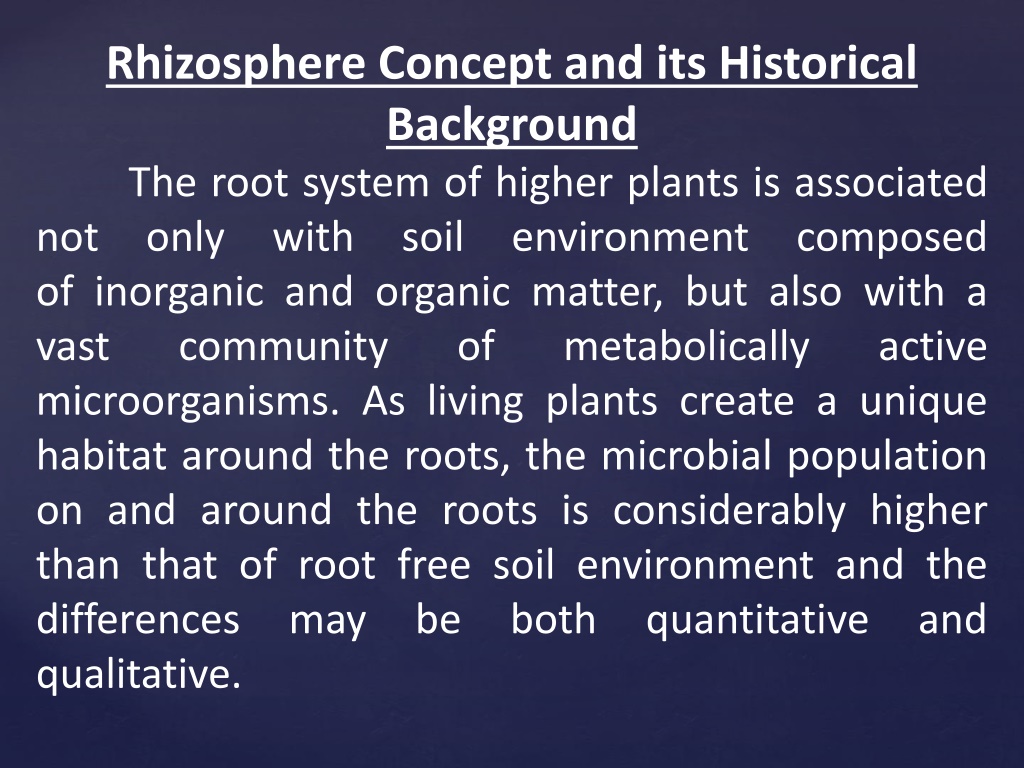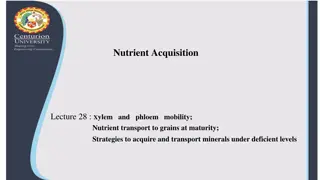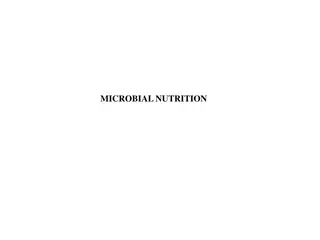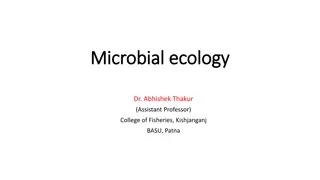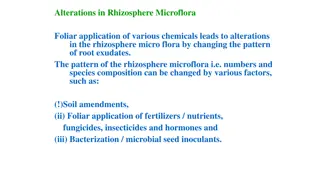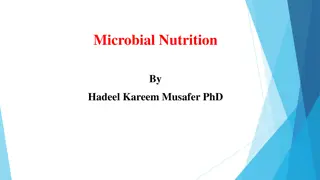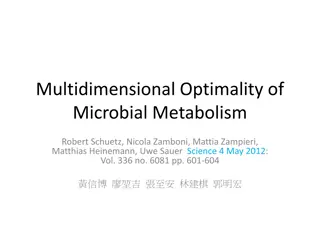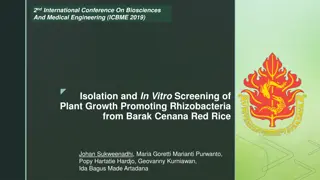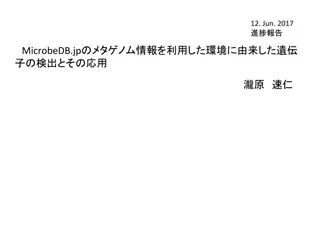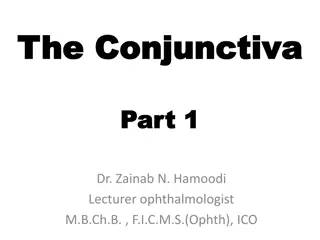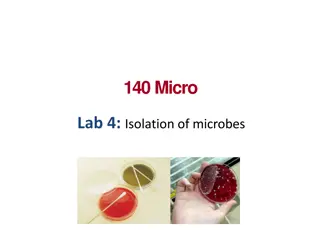Understanding the Rhizosphere: A Historical and Microbial Perspective
The rhizosphere, the region surrounding plant roots, harbors a diverse community of microorganisms influenced by plant roots. Historical background and microbial interactions in the rhizosphere are explored, highlighting the favorable habitat for microbial proliferation and metabolism. Various techniques are used to study microbial populations and their interactions within this unique root-associated environment.
Download Presentation

Please find below an Image/Link to download the presentation.
The content on the website is provided AS IS for your information and personal use only. It may not be sold, licensed, or shared on other websites without obtaining consent from the author. Download presentation by click this link. If you encounter any issues during the download, it is possible that the publisher has removed the file from their server.
E N D
Presentation Transcript
Rhizosphere Concept and its Historical Background The root system of higher plants is associated not only with soil environment composed of inorganic and organic matter, but also with a vast community of microorganisms. As living plants create a unique habitat around the roots, the microbial population on and around the roots is considerably higher than that of root free soil environment and the differences may be both quantitative and qualitative. metabolically active
1) Rhizosphere: It is the zone/region of soil immediately surrounding the plant roots together with root surfaces, or it is the region where soil and plant roots make contact, or it is the soil region subjected to influence of plant roots and characterized by increased microbial. 2) Rhizoplane: Root surface along with the closely adhering soil particles is termed as rhizoplane.
Historical Background: Term "Rhizosphere" was introduced for the first time by the German scientist Hiltner (1904) to denote that region of soil which is subjected to the influence of plant of "Rhizosphere Phenomenon" which shows the mutual interaction microorganisms was came into existence with the work of Starkey et al (1929), Clark (1939) and Rauath and Katznelson (1957). roots. The concept of roots and
Microorganisms in the Rhizosphere and Rhizosphere Effect The rhizosphere region is a highly favorable habitat for the proliferation, metabolism of numerous microorganisms. The rhizosphere microflora enumerated intensively by microscopic, cultural and biochemical techniques. techniques reveal the types of organisms present and their physical association with the outer root tissue surface / root hairs. The cultural technique most commonly followed is "serial dilution and plate count method "which reveal the quantitative and qualitative population of micro flora. activity and can be Microscopic
At the same time, a cultural method shows the selective enhancement categories of bacteria. The biochemical techniques used are designed to measure a specific change brought about by the plant or by the microflora. The rhizosphere effect on most commonly found microorganisms viz. bacteria, actinomycetes, fungi, algae and protozoa is being discussed here with in the following paragraphs. of certain
A. Bacteria: The greater rhizosphere effect is observed with bacteria (R: S values ranging from 10-20 or more) than with actinomycetes and fungi. Gram-negative, rod shaped, non- sporulating bacteria which respond to root exudates are predominant in Pseudomonas, Agrobacterium). While Gram- positive, rods, Cocci and aerobic and non aerobic spore forming (Bacillus, Clostridium) are comparatively rare in the rhizosphere. the rhizosphere
The most common genera of bacteria are: Pseudomonas, Arthrobacter, Alcaligenes, Mycobacterium, Flavobacter, Micrococcus and others have been reported to be either abundant or sparse in the rhizosphere. From the agronomic point of view, the abundance of nitrogen fixing and phosphate solubilizing bacteria in the rhizosphere assumes a great importance. Agrobacterium, Azotobacter, Cellulomonas,
The aerobic bacteria are relatively less in the rhizosphere because of the reduced oxygen levels due to root respiration. The bacterial population in the rhizosphere is enormous in the ranging from 108 to 109 per gram of rhizosphere soil. They cover about 4- 10% of the total root area occurring profusely on the root hair region and rarely in the root tips. There is predominance of amino acids and growth factors required by bacteria, are readily provided by the root exudates in the region of rhizosphere.
B. Fungi: In contrast to their effects on bacteria, plant roots do not alter / enhance the total count of fungi in the rhizosphere. However, rhizosphere effect is selective and significant on specific fungal genera (Fusarium, Verticillium, Aspergillus and Penicillium) which are stimulated. The R:S ratio of fungal population is believed to be narrow in most of the plants, usually not exceeding to 10.The soil / serial dilution and plating technique used enumeration of rhizosphere fungi may often give erratic results as most of the spore formers produce abundant colonies in culture media giving a wrong picture / estimate (eg Aspergilli and Penicillia). for the
In fact the mycelial forms are more dominant in the field. The zoospore / forming lower fungi such as Phytophthora, Pythium, Aphanomyces are strongly attracted to the roots in response to particular chemical compounds excreted by the roots and cause diseases under favorable conditions. Several fungi eg and fujikurio produces phytohormones and influence the plant growth. Gibberella
C. Actinomycetes, Protozoa and Algae: Stimulation of actinomycetes in the rhizosphere has not been studied in much detail so far. It is generally understood that the actinomycetes are the rhizosphere than bacteria. However, when antagonistic actinomycetes increase in number they suppress bacteria. Actinomycetes may also increase in number when antibacterial agents are sprayed on the crop. Among the actinomycete, the phosphate solublizers (eg. Nocardia, Streptomyces) have a dominant role to play. less stimulated in
As role of actinomycetes, protozoa and algae are not significantly influenced by their proximity to the plant roots and their R: S ratios rarely exceed 2 to 3: 1 and around roots of plants, R: S ratio for these microorganisms may go to high. Because of large bacterial community, an increase in the number or activity of protozoa is expected in the rhizosphere. Flagellates and amoebae are dominant and ciliates are rare in the region.
Factors affecting microbial flora of the Rhizosphere / Rhizosphere Effect The most important factors which affect / influence the microbial flora of the rhizosphere or rhizosphere effect are: soil type & its moisture, soil amendments, soil PH, proximity of root with soil, plant species, and age of plant and root exudates. A) Soil type and its moisture: In general, microbial activity and population is high in the rhizosphere region of the plants grown in sandy soils and least in the high humus soils, and rhizosphere organisms are more when the soil moisture is low.
Thus, the rhizosphere effect is more in the sandy soils with low moisture content. B) Soil amendments and fertilizers: Crop residues, animal manure and chemical fertilizers applied to the soil cause no appreciable effect on the quantitative or qualitative differences in the micro flora of rhizosphere. In general, the character of vegetation is more important than the fertility level of the soil. C)Soil PH/ Rhizosphere PH: Respiration by the rhizosphere micro flora may lead to the change in soil rhizosphere PH.
If the activity and population of the rhizosphere micro flora is more, then the PH of rhizosphere region is lower than that of surrounding soil or non-rhizosphere soil. Rhizosphere effect for bacteria and protozoa is more in slightly alkaline soil and for that of fungi is more in acidic soils. D) Proximity of root with Soil: Soil samples taken progressively closer to the root system have increasingly greater population of bacteria, and actinomycetes and decreases with the distance and depth from the root system. Rhizosphere effect decline sharply with increasing distance between plant root and soil.
E) Plant Species: Different plant species inhabit often somewhat variable micro rhizosphere region. quantitative differences are variations in the rooting composition and excretion products. In general, legumes show / produce a more pronounced rhizosphere effect than grasses or cereals. Biennials, due to their long growth period exert more prolonged stimulation on rhizosphere effect than annuals. flora qualitative attributed to habits, in the and The tissue
F) Age of Plant: The age of plant also alter the rhizosphere micro flora and the stage of plant maturity controls the magnitude of rhizosphere effect and degree of response to specific rhizosphere micro flora increases in number with the age of the plant and reaching at peak during flowering which is the most active period of plant growth and metabolism. Hence, the rhizosphere effect was found to be more at the time of flowering than in the seedling or full maturity stage of the plants. microorganisms. The
The and increases even after fruiting and the onset of senescence due to moribund tissue and sloughed off root parts / tissues: whereas, bacterial flora of the rhizosphere decreases after the flowering period and fruit setting. G)Root / exudates /excretion: One of the most important factors responsible for rhizosphere effect is the availability of a great variety of organic substances at the root region by way of root exudates/excretions. fungal Amylolytic) of the rhizosphere usually flora (especially, Cellulolytic accumulation of
The quantitative and qualitative differences in the micro flora of the rhizosphere from that of general soil are mainly due to influences of root exudates. The spectrum of chemical composition root exudates varies widely, and hence their influence on the micro flora also varies widely. The nature and amount of chemical substances thus exuded are dependent on the species of plant, plant age, inorganic nutrients, and temperature, light intercity, O2 / CO2 level, root injury etc.
Another microorganisms in the rhizosphere region is the sloughed off root epidermis which exert selective stimulation effect on some specific groups of microorganisms. For instance, glucose and amino acids in the exudates readily attract Gram- negative rods which predominantly colonize the roots. Sugars and amino acids in the root exudates stimulate chlamydospores and other resting spores of fungi; stimulation effect of root exudates on plant pathogenic fungi, nematodes is also well known. source of nutrients for the the germination of
INTRODUCTION Soil is comprised of inorganic (mineral) and organic components. A notable characteristic of soil is surface accumulation of organic matter (a driving force for pedogenesis on any mineral substrate in any place), from the overlying floral and faunal communities. Humus, a dark coloured amorphous product of plant and animal matter decomposition is an integral component of the soil system. It is vital for most biological and physico- chemical process happens in soil. The term humus is used to describe both incorporated humus detritus (soil organic matter) and surface humus layers litter (or surface accumulations).
Humus (natural organic matter, NOM) or humic substances persist in soils throughout its profile development. It is decomposing products of decomposition and is complex and rather resistant mixture of brown or dark brown amorphous and colloidal substances modified from the original tissues (plants as well as animals) or synthesized by various soil organisms. composed of slow
FORMATION OF HUMUS Humus is a product of decomposition of organic matter. By the time plant and animal matter becomes humus, the materials is partly decomposed and chemically stabilized. In the soil microorganisms act on the dead plant and animal remains, degrade, and decompose them into simpler organic compounds. A product of this microbial decomposition is humus, which is a dark coloured, amorphous substance, composed of residual organic matters not readily decomposed by the organisms.
When detrital carbon (carbon from plant, microbial and animal residues) is processed by decomposer organisms (largely microbes) in the soil, the carbon is either lost as carbon dioxide, incorporated into the cells of the decomposer organisms, or enters a carbon pool that is relatively stable either as a result of physical protection from attack by decomposers or chemical protection . It seems that physically protected organic matter is related to the structural characteristics of the soil, whereas chemically protected organic matter is related to the chemical processes in the soil and referred to as soil humus.
Incomplete decomposition of detritus (dead and decaying plant and animal matters) leads to production of humus in an ecosystem. Under less than ideal conditions for decomposition, a portion of the litter entering the soil system is not completely decomposed, but is modified into humus, which may decompose slowly and hence accumulate.
The first and most important aspect of humus formation is shredding of organic matter (detritus), which will be performed by saprophagous fauna (earthworms, millipedes, snails, enchytraeids etc.) followed by microorganisms subsequently be subjected to further chemical transformations. It is found that around 90% of the organic matter has been processed by two of these animal groups, enchytraeids and earthworms. the decomposition process from litter to humus has two stages. , which will
In the first stage, there is rapid loss of solubles (sugars, starches, proteins) followed by cellulose, but a little loss or sometimes-even gain of lignin (insoluble decay products). During this stage, carbon is relatively available and nutrients are limiting, and there is immobilization of the nutrients such as N. Once the litter reaches the second stage, it can be considered as humus, it has stabilized contents and slow decomposition rate. During the late stage of decay, there is net loss of lignin and N mineralization.
The critical determining factor for the rate of humus accumulation on a site is how much of the original litter mass remains at a point at which the materials gets converted to humus and decomposition slows down. CO2 Residue C Decomposer biomass C Physically and chemically protected organic matter C
FACTORS CONTROLLING HUMIFICATION The major factors that influence the rate of humification are( nature of plants, animals or soil organisms, rate of decomposition, temperature and aeration and moisture). All these aforesaid factors are more or less interrelated. The participation of the plant cover in humus formation is determined by the amount and nature of the plant residues, their mode of admission into the soil and the nature of their decomposition. Litter is the main source of humus in forest soils (in the absence of grass cover), and organic matter enters the soil layers in the form of leachates form litter.
The quantum of humus formed by woody species is less than that of grass vegetation, as the roots of woods species are thick and long living. Local micro meteorological conditions are considered good predictors of decomposition rates and good relationships exist between temperature or actual evapotranspiration and rates of litter decomposition. Temperature proportional to the rate of humification up to a certain extent as an increase in temperature increases the rate. is directly
Good aeration and moisture content in soil also stimulates the humification process. The chemical nature of litter is probably the most significant factor influencing the proportion that becomes humus. The availability of microorganisms and the extent of their activity influence the process of humification to a maximum extent, as these are the main drivers of the process. The whole complex of processes by which plant residues are transformed and finally converted into humus is the result of combined activity of associations of microbes exhibiting diverse biochemical functions.
The humus reserve of the soil is determined by the ratie of the two processes the new formation and decomposition of humus substances. The amount of humus in different soils varies greatly depending on the factors as discussed above. It shows spatial as well as temporal variations. It is less in arid soils and very high in humid soils. Even in the same soil type, it varies through different horizons of the soil profile. In the top layer of the soil, humus quantity is greater than that in the deeper layers, as the availability of fresh or partly decayed detrital matter is higher in the top layer of the soil. In humid areas with dense forest or vegetal cover,
The humus may be found in the four stages of degradation 1-Litter low degree of decomposition 2- duff layer: partially decomposed organic matter 3- leaf moulds: simpler decomposition 4- peat: undecomposed organic materiales remains under anaerobic conditions, the dead remains are not at all acted upon by microorganisms.
The role of disturbances In addition to the rate of organic matter decomposition, the accumulation of humus in a site depends on the type, frequency and intensity of disturbance. 1)Anthropogenic activities rather than natural disturbances are major factors that interfere in the process of humification. Forest fire, intensive cultivation and extensive use of chemical fertilizers are known to be major practices that interfere with the 2)natural dynamics of humus in the soil. Even insect outbreaks may affect the rate of humus decomposition and accumulation directly by altering the quality and quantity of litter fall and indirectly by reducing canopy cover and changing soil moisture and temperature conditions.
Role of humus in soil Soil organic matter (SOM) has been extensively examined because of its importance for soil fertility and productivity. Moreover, its importance for establishing favourable physical conditions and architecture in soil is well known. It contributes a lot to chemical, physical as well as biological properties of soil. Humus is known to fulfill multiple functions in soil formation and soil fertility. The humus makes the soil fertile, provides nutrients to the plants and microorganisms, increases availability of minerals in dissolved state to plants on complete decomposition and it forms several organic acids that serve as solvents for soil materials.
Humus has got high capacity for retaining water, because it is porous, thus increasing the water retention capacity of soils. It acts as a cementing agent for binding the sand particles and increases the rate of nutrient uptake by plants. Optimum humus content in soil assures an agronomically valuable structure, a favourable water-air regime, and provides better progressive warming-up of soil. Most important physico-chemical soil indices such as high cation exchange capacity, acid-base buffering capacity of soils, etc are related to humus.
Functions/ Important Role of Humus: 1- It improves physical condition of soil. 2- Improve water holding capacity of soil. 3- Serve as store house for essential plant nutrients. 4- Plays important role in determining fertility level of soil. 5- It tend to make soils more granular with better aggregation of soil particles. 6- Prevent leaching losses of water soluble plant nutrients.
7- Improve microbial/biological activity in soil and encourage better development of plant- root system in soil. 8- Act as buffering agent i.e. prevent sudden change in soil PH/soil reaction. 9- Serve as source of energy and food for the development of soil organisms. 10- It supplies both basic and acidic nutrients for the growth and higher plants. 11- Improves aeration and drainage by making the soil more porous development of
Besides all these important roles, humus plays some limiting roles. humus has been regarded as the very essence of soil fertility and also a necessary evil . Humus may also be viewed as a nutrient sink( ( that competes with trees for growth-limiting resources. Especially in the case of surface accumulations, immobilization of nutrients into humus may over time 1-deplete the supply of available nutrients and reduce site productivity. accumulations may also germination and growth. Humus can also be an 3- energy trap because of its long residence time in the soil. the progressive Surface 2-hinder humus seedling
In addition to agronomic as well as pedologic importance, humus is ecologically. . Being a part of the detritus based food chain; it plays a key role in energy as well as material circulation in the ecosystem (as detritus food chain is very important for the circulation of materials). Detritus based food chain is less dependent on direct solar energy; it depend chiefly on the influx of organic matter produced in another trophic system. Hence, availability of nutrients and energy locked up in the falling detritus to the soil depends on the rate of decomposition, and humification. equally important
As decomposition rate gets speeded up, mineralisation takes place releasing nutrients as well as energy into the soil system, which will be available for recirculation in the entire cycle.
HUMUS-Nature and characteristics 1- Humus is not soluble in water. 2- colloids 3- black colour 4- composed of carbon, hydrogen and oxygen, probably in the form of modified lignin, polyuronides and polysaccharides. 5-high surface area 6- negatively charged 7- cation exchange capacity 8-high water holding capacity 9- low plasticity and cohesion 10-optical characteristics in response to light.
OPTICAL FEATURES OF HUMIC SUBSTANCES Being colloidal in nature humic substances absorb light spectrum at different wavelengths. The optical properties and in particular the optical density of humus substances depend on their chemical structure. Moreover, the optical density or the absorbance at a particular wavelength varies with their origin, as it determines their composition, and reflects the degree of humification. The ratio of absorbance of humic substances at different wavelengths is used as a parameter of humification for characterizing them (HAs and FAs). It has been found that the ratio of absorbance at 400 and 600 nm of humic substances ( E4/ E 6 ratio), which decreases with increasing molecular weight and condensation of humic substances, can be used as an index of humification.
Humus: The group composition The chemical group composition of humus is the quantitative content of the groups of specific and non-specific compounds that constitute humus. The most important broad groups are the humic acids, hymatomelanic acids, fulvic acids and groups of non-specific compounds (mostly lipids). The group composition of humus is a function of biochemical activity of soils that reflects the specificity of the process of humification in different types of soils.
Humus is mainly made up of the humic group and non-humic group. The humic group which make up about 60-80% of the soil organic matter, are comprised of the most complex resistant materials, characterised by aromatic, ring-type structures that include polyquinones, which are complex and are formed by decomposition, synthesis and polymerisation. The humic substances have no sharply defined physical or chemical properties unlike non-humic compounds. These amorphous, dark materials have high to very high molecular weights, varying from a few hundred to several thousand Daltons. polyphenols and
Humic substances are classified into three chemical groupings on the basis of resistance to degradation (residence time in soil) and of solubility in acids and alkalis. Fulvic acid, the most easily degraded compound is still quite stable in the soil and is more resistant to microbial attack than most freshly applied crop residues. Depending on the environment under natural conditions it may take 15-50 years to destroy fulvic acid type compounds and hundreds of years for humic acid in the soil.
It is found that anthropogenic interference can considerably change the situation. The three humic groups have some similarity with regard to the ability to absorb and release cations. The non- humic group, comprises about 20-30% of the soil organic matter are less complex and less resistant to microbial attack than those of the humic group. They are comprised of specific organic compounds with definite physical and chemical properties. The compounds coming under this category are polysaccharides, polyuronides and organic acids. These are produced as result of microbial synthesis.
